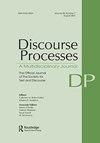认知与交际策略
IF 2.1
2区 心理学
Q2 PSYCHOLOGY, EDUCATIONAL
引用次数: 0
摘要
在交流时,对话者通过提出要添加到他们共同基础上的命题内容来协商知识。说话者提出命题内容的方式——或多或少地表达对其真实性的信心——可能会影响其他对话者对该内容的反应。本文考察了说话人的生产选择和听者对believe/know/bare断言的解释,以检验(最大)确定性是如何表达和推断的,说话人是否会根据他们的交际目标调整他们的生产选择,听者是否能够相应地调整他们的解释。为此,我们创建了两个场景——一个具有合作的对话者,另一个具有潜在的不合作的对话者。结果表明,“知道”在认识论上是最有力的表述——比“赤裸裸的断言”更有力——但在合作场景中,“赤裸裸的断言”可能仍然比“知道”更能表达最大的确定性。我们的研究结果还表明,在合作环境中,信念被用来对冲陈述的自信强度。虽然说话者和听者在表述的相对认知顺序上是一致的(相信<断言<知道),但在推断说话者的信念程度时,听者似乎并没有始终考虑到说话者的交际目标可能会随着语境的变化而变化。本文章由计算机程序翻译,如有差异,请以英文原文为准。
Epistemicity and communicative strategies
When communicating, interlocutors negotiate knowledge by proposing propositional content to be added to their shared common ground. The way in which speakers put forward propositional content – expressing more or less confidence in its truthfulness – may affect the way in which other interlocutors react to such content. This article examines speakers’ production choices and hearers’ interpretations of the formulations believe/know/bare assertion to test how (maximal) certainty is expressed and inferred, whether speakers adjust their production choices depending on their communicative goals and whether hearers are able to adjust their interpretations correspondingly. For this purpose, we created two scenarios – one with a cooperative interlocutor and one with a potentially uncooperative interlocutor. The results suggest that know is epistemically the most powerful formulation – stronger than the bare assertion – but that the bare assertion may still be preferred over know for expressing maximal certainty in cooperative scenarios. Our findings also suggest that believe is used to hedge the assertive strength of statements in cooperative settings. Whereas speakers and hearers agree in the relative epistemic ordering of the formulations (believe < bare assertion < know), when inferring the speakers’ degrees of belief hearers to not appear to consistently take into account that speakers’ communicative goals may shift as a function of context.
求助全文
通过发布文献求助,成功后即可免费获取论文全文。
去求助
来源期刊

Discourse Processes
Multiple-
CiteScore
4.30
自引率
4.50%
发文量
27
期刊介绍:
Discourse Processes is a multidisciplinary journal providing a forum for cross-fertilization of ideas from diverse disciplines sharing a common interest in discourse--prose comprehension and recall, dialogue analysis, text grammar construction, computer simulation of natural language, cross-cultural comparisons of communicative competence, or related topics. The problems posed by multisentence contexts and the methods required to investigate them, although not always unique to discourse, are sufficiently distinct so as to require an organized mode of scientific interaction made possible through the journal.
 求助内容:
求助内容: 应助结果提醒方式:
应助结果提醒方式:


